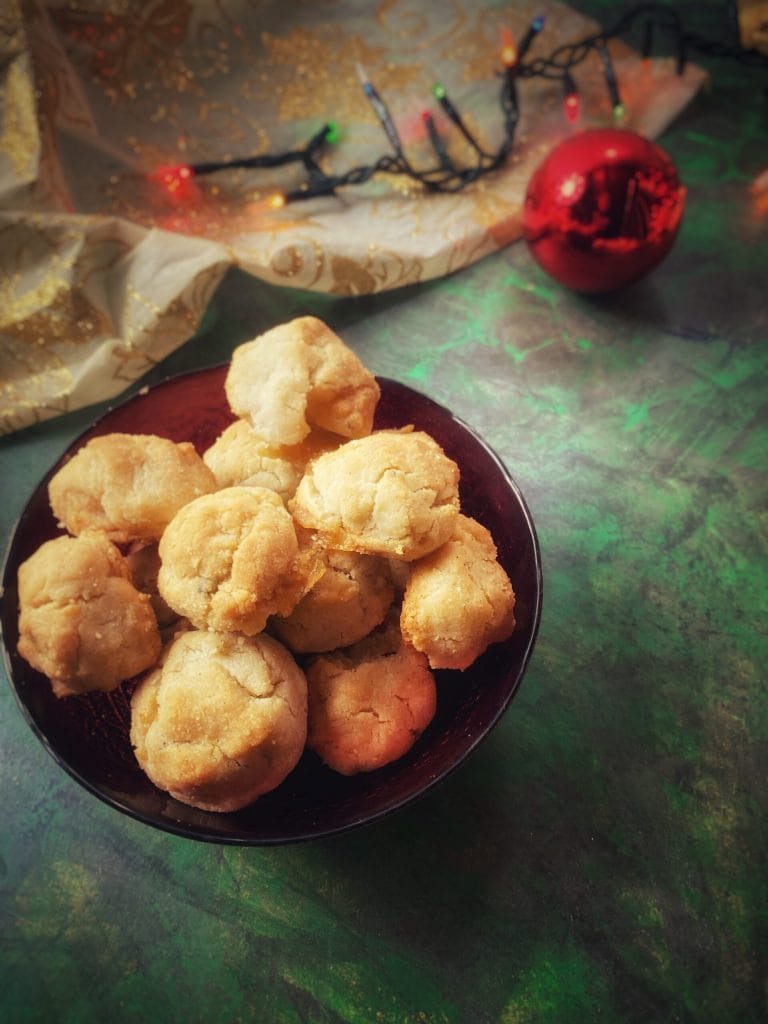Pebernødder are small spiced cookies.
They are called pfeffernüsse (plural, singular is Pfeffernuss) in German, pepernoten (sing. pepernoot) in Dutch, päpanät in Plautdietsch (Low Prussian dialect), pfeffernusse or peppernuts in English and peppernøtter in Norwegian, pepparnötter in Swedish and pebernødder in Danish.
Although the recipes vary, they all contain spices, most commonly cardamom, nutmeg, cinnamon, cloves, ginger, white pepper, mace, and anise.
The dough is based on spices, butter, sugar, cream, hjortetaksalt (a leavening agent that can be replaced with baking powder or baking soda) and flour.
Popular as a holiday treat among ethnic Germans and Mennonites in North America.
The name literally means “pepper nuts”, and it doesn’t mean they contain nuts, but because they are about the size of nuts and can be eaten by the handful.
Medieval ones were very different, made with rye flour, honey, and a much stronger concentration of herbs. They were hard, as the name indicates, like nuts.
They also take their name from the pinch of pepper added to the dough before baking.
Pebernødder are part of the traditional Christmas cookie triad: Brunkager, Pebernødder, and Vaniljekranse.
These are often served together and form the backbone of Christmas cookies in Denmark.

- Difficulty: Easy
- Cost: Very affordable
- Preparation time: 5 Minutes
- Portions: 25 Pieces
- Cooking methods: Oven
- Cuisine: Danish
- Seasonality: Christmas
Ingredients
- 4.4 oz sugar
- 4.4 oz butter
- 1/3 cup cream
- to taste ground ginger
- to taste ground cinnamon
- to taste cardamom
- 8.8 oz flour
- 1 hjortetaksalt (or baking powder)
- 2 pinches white pepper
Steps
Mix the butter with sugar, add the cream, spices, hjortetaksalt or baking powder, and flour.
Create balls of about 0.8 inches, sprinkle with white pepper, and bake in the oven at 375°F for 17 minutes.

FAQ (Questions and Answers)
What are the other variations of Pebernødder?
The Netherlands give the name Kruidnoten to the small, brown, round cookies, while pepernoten refers to a chewy snack that is lighter in color and has a chunky, angular appearance. Although they are perceptibly different, some Dutch residents mistakenly call kruidnoten pepernoten and even online shops list them in this category.
Both are exclusive holiday snacks and can be found in any store that sells food during Sinterklaas.
Meanwhile, the kruidnoten recipe has become the subject of experimentation and has significantly expanded over the years.
In addition to the regular variant and packages that include gummy and sugar candies, kruidnoten can be coated with a layer of chocolate (white/milk/dark/truffle) – one of the first and most loved variants – but also strawberry, caramel, coconut, coffee, bubblegum, cake (any), etc.
Pebernødder are often confused with kruidnoten. Though both are famous holiday cookies, kruidnoten are harder, have a darker brown color, and a different shape.
Their ingredients are more similar to those used in speculaas.
In Northern Germany, they are called Pfeffernüsse and are a hemispherical sweet with a diameter of up to two centimeters and a firm texture.
The northern variant of Moppen is larger and softer, based on a gingerbread-like dough and has a glaze.
In southern Germany, the dough is prepared with candied lemon or orange peel, orange zest, lemon zest, and often almonds.
In Saxony, they are about three centimeters, uncoated, and angular.
There are some recipes passed down by families of German Mennonite origin that call for peppermint extract instead of the traditional spices, creating a mild mint flavor. These are baked until soft and covered with powdered sugar.
Even American Russian tea cakes are often confused with Pebernødder, especially when dusted with powdered sugar.What is hjortetaksalt?
Also called deer salt, it is a baking additive that gives them crispness and is therefore used in cookies, brownies, cookies, etc.
Its chemical name is ammonium bicarbonate (NH 4 HCO 3) and it has the electronic number E-503.

